Technical Data Synchronous Belts / Belt Sprockets Design Guide
Layout Design
Installation of guide flanges
The synchronous belt when running tends to deviate in the axial direction of the belt sprockets. In order to prevent the synchronous belt from coming off the belt sprockets, guide flanges are installed on the belt sprockets. The guide flange installation standard is as follows:
Horizontal-shaft transmission
Install guide flanges on both sides of either belt sprocket or on one side of one belt sprocket and another flange on the opposite side of the other belt sprocket. (ex. 1)
Where the belt sprocket center distance is greater than 8 times the outside diameter of the small belt sprocket, install guide flanges on both sides of both belt sprockets. (ex. 2)
(ex. 1)

(ex. 2)
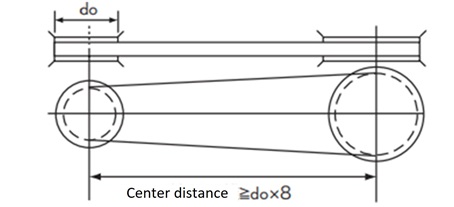
Vertical-shaft transmission
Since the belt is likely to disengage downward, install guide flanges on both sides of one belt sprocket and another guide flange on the lower side of the other belt sprocket.
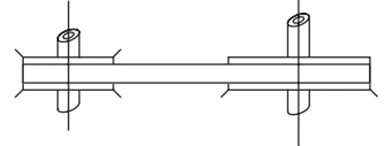
Multiple-shaft transmission
Install guide flanges on both sides of every other belt sprocket (Example 3) or install guide flanges on one side of all belt sprockets alternately (Example 4).

Use of an idler
Idler is used in the following cases.
- ・The distance between the shafts are fixed and an idler is used for adjustment of the installation tension.
- ・The speed ratio is large and the number of meshing teeth of the small belt sprocket needs to be increased.
- ・No belt guide can be used on the drive and driven belt sprockets.
Precautions for using the idler
- ・The idler must be stationary and as a rule be used on the slack side
- ・Note that if the parallelism between the axis of the idler and the axes of both belt sprockets is poor, the idler may cause the belt to disengage from the belt sprockets.
- ・Determine the idler diameter according to the following criteria.
- Inside idler ...A timing belt sprocket having the number of teeth greater than the minimum number of teeth of belt sprocket in the following table.
- Outside idler ...A flat belt sprocket that is greater than 1.2 times the pitch circle diameter of the belt sprocket in the following table and does not have a crown.
Minimum number of teeth of belt sprocket for selection of an idler
| Types | Speed r/min | |||
|---|---|---|---|---|
| Up to and incl. 900 | Over 900, up to and incl. 1200 | Over 1200, up to and incl. 1800 | Over 1800, up to Type and incl. 3600 | |
| P2M | 16 | 16 | 18 | 20 |
| P3M・UP3M | 14 | 14 | 16 | 18 |
| P5M・UP5M | 18 | 20 | 24 | 28 |
| P8M・UP8M | 24 | 26 | 26 | 28 |
| P14M・UP14M | 28 | 28 | 28 | 34 |
Note) For revolutions above 3600 r/min, refer to the Standard Transmission Capacity Table.
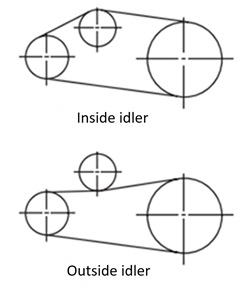
Adjustment of distance between two axes
In the transmission of only driving and driven belt sprockets, without using an idler, provide the adjusting margin of the distance between axes at the bearing including the manufacturing length (tolerance) of belt.
Adjusting margin of inter-axial distance
| Belt length | Types | ||
|---|---|---|---|
| P2M・P3M・P5M UP3M・UP5M |
P8M・P14M UP8M・UP14M |
||
| △Co | Up to and incl. 500 | 3 | 3 |
| 500~1000 | 5 | 5 | |
| 1001~2000 | 10 | 10 | |
| 2000 or more | 15 | 15 | |
| △Ci | Common | 10 | 15 |
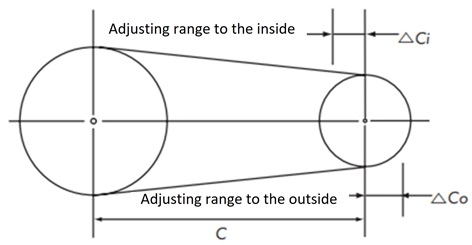
Installation tension and axial load
Belt installation tension
Synchronous Belt drive requires an adequate installation tension to prevent jumping teeth and to ensure smooth drive. A small installation tension tends to cause mismatching of tooth meshing and a large tension tends to cause noises, both of which shorten the service life. A sound sonic belt tension meter that can measure the tension accurately is available.
How to apply an installation tension
- 1. Accurately establish the parallelism of all shafts including the idler shaft and belt sprocket alignment.
- 2. Apply a force (F) to the center of the span of the belt.
- 3. Apply a tension that makes the deflection(δ)of the belt 1.6 mm per 100 mm of span.
How to obtain the push force (F)
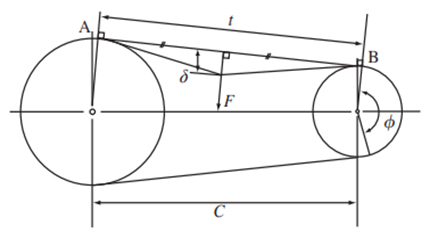
F = Ti + t × Y L 16
- F:Push force required for deflection(δ)at the center of the span t N{kgf}
- Ti:Initial tension N{kgf}
- Y:Correction factor
- δ:Deflection mm=0.016t
- t:Span length mm
t = C2 - (Dp - dp)2 4
- C:Distance between shafts mm
- Dp:Pitch circle diameter of large belt sprocket mm
- dp:Pitch circle diameter of small belt sprocket mm
- L:Belt length mm
Axial load
The axial load is obtained by the following equation.
Axial load = 2Ti × sin Φ 2
- Ti:Initial tension N{kgf}
- Φ:Winding angle of small belt sprocket degrees
List of installation tension
Ultra PX Belt HC Type
| Types (Pitch ) |
Belt width mm |
Initial tension Ti N {kgf} | Correction factor Y N {kgf} | |
|---|---|---|---|---|
| Recommended value | Maximum value | |||
| UP3M-HC | 6 | 29 {3.0} | 40 {4.1} | 38.5 {3.9} |
| 10 | 52 {5.3} | 72 {7.3} | 61.8 {6.3} | |
| 15 | 82 {8.4} | 114 {11.6} | 90 {9.2} | |
| UP5M-HC | 10 | 108 {11.0} | 147 {15.0} | 102.7 {10.5} |
| 15 | 171 {17.4} | 232 {23.7} | 152 {15.5} | |
| 20 | 238 {24.3} | 323 {32.9} | 200.7 {20.5} | |
| 25 | 307 {31.3} | 418 {42.6} | 249.1 {25.4} | |
| 30 | 377 {38.4} | 513 {52.3} | 297.2 {30.3} | |
| 35 | 450 {45.9} | 613 {62.5} | 344.9 {35.2} | |
| 40 | 524 {53.4} | 713 {72.7} | 392.5 {40.0} | |
| UP8M-HC | 15 | 177 {18.0} | 235 {24.0} | 190.6 {19.4} |
| 20 | 244 {24.9} | 324 {33.0} | 246 {25.1} | |
| 25 | 317 {32.3} | 421 {42.9} | 299.9 {30.6} | |
| 30 | 389 {39.7} | 517 {52.7} | 352.6 {36.0} | |
| 35 | 464 {47.3} | 616 {62.8} | 404.3 {41.2} | |
| 40 | 540 {55.1} | 717 {73.1} | 455.1 {46.4} | |
| 45 | 618 {63.0} | 820 {83.6} | 505.2 {51.5} | |
| 50 | 697 {71.1} | 926 {94.4} | 554.7 {56.6} | |
| 55 | 777 {79.2} | 1032 {105.2} | 603.7 {61.6} | |
| 60 | 859 {87.6} | 1140 {116.2} | 652.2 {66.5} | |
| UP14M-HC | 40 | 794 {81.0} | 1050 {107.1} | 834 {85.0} |
| 60 | 1255 {128.0} | 1659 {169.2} | 1242.7 {126.7} | |
| 80 | 1747 {178.1} | 2310 {235.6} | 1649.0 {168.2} | |
| 100 | 2255 {229.9} | 2982 {304.1} | 2053.6 {209.4} | |
| 120 | 2771 {282.6} | 3665 {373.7} | 2456.9 {250.5} | |
Ultra PX Belt HA Type
| Types (Pitch ) |
Belt width mm |
Initial tension Ti N {kgf} | Correction factor Y N {kgf} | |
|---|---|---|---|---|
| Recommended value | Maximum value | |||
| UP5M-HA | 10 | 108 {11.0} | 147 {15.0} | 102.7 {10.5} |
| 15 | 171 {17.4} | 232 {23.7} | 152.0 {15.5} | |
| 20 | 238 {24.3} | 323 {32.9} | 200.7 {20.5} | |
| 25 | 307 {31.3} | 418 {42.6} | 249.1 {25.4} | |
| 30 | 377 {38.4} | 513 {52.3} | 297.2 {30.3} | |
| 35 | 450 {45.9} | 613 {62.5} | 344.9 {35.2} | |
| 40 | 524 {53.4} | 713 {72.7} | 392.5 {40.0} | |
| UP8M-HA | 15 | 177 {18.0} | 235 {24.0} | 190.6 {19.4} |
| 20 | 244 {24.9} | 324 {33.0} | 246.0 {25.1} | |
| 25 | 317 {32.3} | 421 {42.9} | 299.9 {30.6} | |
| 30 | 389 {39.7} | 517 {52.7} | 352.6 {36.0} | |
| 35 | 464 {47.3} | 616 {62.8} | 404.3 {41.2} | |
| 40 | 540 {55.1} | 717 {73.1} | 455.1 {46.4} | |
| 45 | 618 {63.0} | 820 {83.6} | 505.2 {51.5} | |
| 50 | 697 {71.1} | 926 {94.4} | 554.7 {56.6} | |
| 55 | 777 {79.2} | 1032 {105.2} | 603.7 {61.6} | |
| 60 | 859 {87.6} | 1140 {116.2} | 652.2 {66.5} | |
| UP14M-HA | 40 | 794 {81.0} | 1050 {107.1} | 834.0 {85.0} |
| 60 | 1255 {128.0} | 1659 {169.2} | 1242.7 {126.7} | |
| 80 | 1747 {178.1} | 2310 {235.6} | 1649.0 {168.2} | |
| 100 | 2255 {229.9} | 2982 {304.1} | 2053.6 {209.4} | |
| 120 | 2771 {282.6} | 3665 {373.7} | 2456.9 {250.5} | |
Ultra PX Belt HY type
| Types (Pitch ) |
Belt width mm |
Initial tension Ti N {kgf} | Correction factor Y N {kgf} | |
|---|---|---|---|---|
| Recommended value | Maximum value | |||
| UP3M-HY | 6 | 39 {4.0} | 47 {4.8} | 76.0 {7.7 } |
| 10 | 68 {6.9} | 82 {8.4} | 118.2 {12.1} | |
| 15 | 105 {10.7} | 127 {13.0} | 167.7 {17.1} | |
| UP5M-HY | 10 | 125 {12.7} | 165 {16.8} | 152.5 {15.6} |
| 15 | 194 {19.8} | 256 {26.1} | 223.7 {22.8 } | |
| 20 | 265 {27.0} | 350 {35.7} | 293.6 {29.9} | |
| 25 | 338 {34.5} | 446 {45.5} | 362.6 {37.0 } | |
| 30 | 413 {42.1} | 545 {55.6} | 430.8 {43.9 } | |
| 35 | 488 {49.8} | 644 {65.7} | 498.4 {50.8 } | |
| 40 | 564 {57.5} | 744 {75.9} | 565.4 {57.7 } | |
| UP8M-HY | 15 | 255 {26.0} | 290 {29.6} | 272.0 {27.7 } |
| 20 | 347 {35.4} | 394 {40.2} | 341.3 {34.8 } | |
| 25 | 444 {45.3} | 505 {51.5} | 406.9 {41.5 } | |
| 30 | 541 {55.2} | 615 {62.7} | 469.9 {47.9} | |
| 35 | 640 {65.3} | 728 {74.2} | 530.6 {54.1 } | |
| 40 | 740 {75.5} | 841 {85.8} | 589.6 {60.1 } | |
| 45 | 842 {85.9} | 957 {97.6} | 647.0 {66.0 } | |
| 50 | 944 {96.3} | 1073 {109.4} | 703.0 {71.7} | |
| 55 | 1048 {106.9} | 1192 {121.6} | 757.9 {77.3} | |
| 60 | 1150 {117.3} | 1308 {133.4} | 811.8 {82.8} | |
| UP14M-HY | 40 | 1020 {104.0} | 1225 {124.9} | 1044.3 {106.5} |
| 60 | 1581 {161.2} | 1899 {193.6} | 1537.5 {156.8} | |
| 80 | 2162 {220.5} | 2597 {264.8} | 2023.1 {206.3} | |
| 100 | 2754 {280.8} | 3308 {337.3} | 2053.1 {209.4} | |
| 120 | 3366 {343.2} | 4043 {412.3} | 2978.6 {303.7} | |
PX Belts SHINAYAKA 530(for Endless Belts)
| Types (Pitch ) |
Belt width mm |
Initial tension Ti N {kgf} | Correction factor Y N {kgf} | |
|---|---|---|---|---|
| Recommended value | Maximum value | |||
| P2M-530 | 4 | 5.9 {0.6} | 7.8 {0.8} | 10.0 {1.0 } |
| 6 | 9.4 {1.0} | 12 {1.2} | 16.1 {1.6} | |
| 10 | 17 {1.7} | 22 {2.2} | 28.2 {2.9} | |
| P3M-530 | 6 | 20 {2.0} | 26 {2.7} | 17.6 {1.8} |
| 10 | 36 {3.7} | 47 {4.8} | 29.0 {3.0 } | |
| 15 | 57 {5.8} | 74 {7.5} | 43.1 {4.4 } | |
PX Belts (for Open-ended Belts)
| Types (Pitch ) |
Belt width mm |
Initial tension Ti N {kgf} | Correction factor Y N {kgf} | |
|---|---|---|---|---|
| Recommended value | Maximum value | |||
| P2M | 4 | 5.9 {0.6} | 7.8 {0.8} | 10.0 {1.0 } |
| 6 | 9.4 {1.0} | 12 {1.2} | 16.1 {1.6 } | |
| 10 | 17 {1.7} | 22 {2.2} | 28.2 {2.9} | |
| P3M | 6 | 20 {2.0} | 26 {2.7} | 17.6 {1.8 } |
| 10 | 36 {3.7} | 47 {4.8} | 29.0 {3.0} | |
| 15 | 57 {5.8} | 74 {7.5} | 43.1 {4.4} | |
PX Belt RC Type
| Types (Pitch ) |
Belt width mm |
Initial tension Ti N {kgf} | Correction factor Y N {kgf} | |
|---|---|---|---|---|
| Recommended value | Maximum value | |||
| P2M-RC | 4 | 5.9 {0.6} | 7.8 {0.8} | 10.0 {1.0} |
| 6 | 9.4 {1.0} | 12 {1.2} | 16.1 {1.6} | |
| 10 | 17 {1.7} | 22 {2.2} | 28.2 {2.9} | |
| P3M-RC | 6 | 20 {2.0} | 26 {2.7} | 17.6 {1.8} |
| 10 | 36 {3.7} | 47 {4.8} | 29.0 {3.0} | |
| 15 | 57 {5.8} | 74 {7.5} | 43.1 {4.4} | |
| P5M-RC | 10 | 97 {9.9} | 132 {13.5} | 56.9 {5.8} |
| 15 | 154 {15.7} | 209 {21.3} | 82.4 {8.4} | |
| 20 | 214 {21.8} | 291 {29.6} | 139.0 {14.2} | |
| 25 | 276 {28.2} | 376 {38.4} | 201.0 {20.5} | |
| P8M-RC | 15 | 203 {20.6} | 265 {27.0} | 151.3 {15.4} |
| 20 | 280 {28.5} | 365 {37.3} | 193.0 {19.7} | |
| 25 | 363 {37.0} | 473 {48.3} | 233.0 {23.8} | |
| 40 | 617 {63.0} | 807 {82.3} | 346.6 {35.3} | |
| 60 | 982 {100.1} | 1283 {130.9} | 488.3 {49.8} | |
| P14M-RC | 40 | 990 {101.0} | 1310 {133.6} | 635.5 {64.8} |
| 60 | 1564 {159.5} | 2070 {211.1} | 973.2 {99.2} | |
| 80 | 2178 {222.1} | 2882 {293.9} | 1316.8 {134.3} | |
| 100 | 2812 {286.7} | 3720 {379.3} | 1664.9 {169.8} | |
| 120 | 3455 {352.3} | 4572 {466.2} | 2016.6 {205.6} | |
PX Belt
| Types (Pitch ) |
Belt width mm |
Initial tension Ti N {kgf} | Correction factor Y N {kgf} | |
|---|---|---|---|---|
| Recommended value | Maximum value | |||
| P5M | 10 | 108 {11.0} | 147 {15.0} | 56.9 {5.8} |
| 15 | 171 {17.4} | 232 {23.7} | 82.4 {8.4} | |
| 20 | 238 {24.3} | 323 {32.9} | 139.0 {14.2} | |
| 25 | 307 {31.3} | 418 {42.6} | 201.0 {20.5} | |
| P8M | 15 | 225 {22.9} | 294 {30.0} | 151.3 {15.4} |
| 20 | 311 {31.7} | 406 {41.4} | 193.0 {19.7} | |
| 25 | 403 {41.1} | 526 {53.6} | 233.0 {23.8} | |
| 40 | 686 {70.0} | 897 {91.5} | 346.6 {35.3} | |
| 60 | 1091 {111.3} | 1426 {145.4} | 488.3 {49.8} | |
| P14M | 40 | 990 {101.0} | 1310 {133.6} | 635.5 {64.8} |
| 60 | 1564 {159.5} | 2070 {211.1} | 973.2 {99.2} | |
| 80 | 2178 {222.1} | 2882 {293.9} | 1316.8 {134.3} | |
| 100 | 2812 {286.7} | 3720 {379.3} | 1664.9 {169.8} | |
| 120 | 3455 {352.3} | 4572 {466.2} | 2016.6 {205.6} | |
PX Belt (Waterproof Type)
| Types (Pitch ) |
Belt width mm |
Initial tension Ti N {kgf} | Correction factor Y N {kgf} | |
|---|---|---|---|---|
| Recommended value | Maximum value | |||
| P5M-W | 10 | 108 {11.0} | 147 {15.0} | 50.1 {5.1} |
| 15 | 171 {17.4} | 232 {23.7} | 74.2 {7.6} | |
| 25 | 307 {31.3} | 418 {42.6} | 184.9 {18.9} | |
| P8M-W | 15 | 225 {22.9} | 294 {30.0} | 147.2 {15.0} |
| 25 | 403 {41.1} | 526 {53.6} | 226.7 {23.1} | |
| 40 | 686 {70.0} | 897 {91.5} | 337.3 {34.4} | |
| 60 | 1091 {111.3} | 1426 {145.4} | 475.2 {48.5} | |
Alignment of belt sprocket
Synchronous belt does not turn at belt sprocket center even when belt sprocket-alignment is exact, and it is liable to deviate on either side. Although the force is very small, the belt will be pressed hard against the flange when the belt sprocket-alignment is poor, resulting in premature failure of belt or falling off of flange. Accordingly, adjust the alignment of belt sprocket within the allowable range listed below.
Allowable range of belt sprocket alignment
| Belt Size | All | |||
|---|---|---|---|---|
| Belt width mm | Up to and incl. 30 | 30~50 | 50~100 | Over 100 |
| Allowable degree of parallelization | 51000 or less | 41000 or less | 31000 or less | 21000 or less |
| θ min | Up to and incl. 17 | Up to and incl. 13 | Up to and incl. 10 | Up to and incl. 6 |

How to adjust the belt sprocket
As shown in the figure, the belt sprocket can be aligned in the correct position by placing the straight edge on the reference belt sproket and then bringing the other belt sprockets into contact with the straight edge over the entire surface. (ε=0)
It is possible to obtain axial degree of parallelization simultaneously by making δ in the figure to be lower than Do x allowable degree of parallelization.

Open-ended Belt
Connecting methods
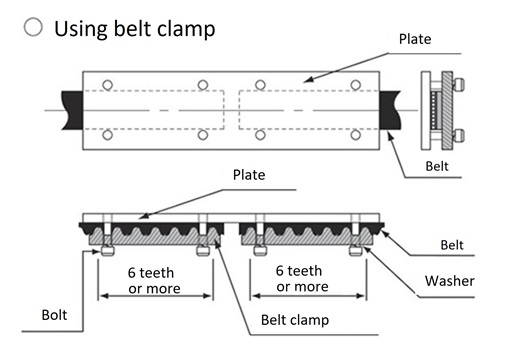
Belt dimensional tolerances
Belt length tolerance
| PX Belt Ultra PX Belt |
tolerance |
|---|---|
| 256 or less | ±0.41 |
| More than 256, up to 3384 | ±0.46 |
| More than 384, up to 3512 | ±0.51 |
| More than 512, up to 3760 | ±0.61 |
| More than 760, up to 1016 | ±0.66 |
| More than 1016, up to 1272 | ±0.76 |
| More than 1272, up to 1528 | ±0.81 |
| More than 1528, up to 1776 | ±0.86 |
| More than 1776, up to 2032 | ±0.91 |
| More than 2032, up to 2288 | ±0.97 |
| More than 2288, up to 2544 | ±1.02 |
| More than 2544, up to 2792 | ±1.07 |
| More than 2792, up to 3048 | ±1.12 |
| More than 3048, up to 3304 | ±1.17 |
| More than 3304, up to 3560 | ±1.22 |
| More than 3560, up to 3808 | ±1.26 |
| More than 3808, up to 4064 | ±1.32 |
| More than 4064, up to 4320 | ±1.37 |
| More than 4320, up to 4576 | ±1.42 |
Belt width tolerance
| Belt width | Belt length | ||
|---|---|---|---|
| 840 or less | More than 840, up to 1680 |
Greater than 1680 |
|
| Up to and incl. 10 | +0.3 -0.6 |
+0.6 -0.6 |
- |
| More than 10, up to 45 | +0.8 -0.8 |
+0.8 -1.2 |
+0.8 -1.2 |
| More than 45, up to 75 | +1.2 -1.6 |
+1.6 -1.6 |
+1.6 -1.6 |
| More than 75, up to 100 | +1.6 -1.6 |
+1.6 -2.0 |
+2.0 -2.0 |
| Greater than 100 | +2.4 -2.4 |
+2.4 -2.8 |
+2.4 -3.2 |
Materials of belt sprockets / Unit Mass
The following materials are suitable for Belt Sprockets:
Materials of belt sprockets / Unit Mass
| Material | material symbol | Unit mass |
|---|---|---|
| Carbon steel for machine structural use | S45C | 7.85 |
| Aluminum alloy | A2017-T4 | 2.8 |
| Stainless Steel | SUS304 | 7.8 |
General equations for Belt Sprockets Design
・Pitch Diameter Dp = N × p π
・Tip Diameter Do = Dp - 2a = N × p π -2a
- p:Belt pitch mm
- N:Number of teeth of belt sprocket
- a:Pitch line depth (PLD)mm
| P3M | P5M | P8M | P14M | |
|---|---|---|---|---|
| p Pitch | 3 | 5 | 8 | 14 |
| a(PLD) | 0.381 | 0.571 | 0.686 | 1.397 |
The outer diameter of P14M standard belt sprockets in the catalog includes a correction value, so there are some that do not follow this formula.
Tolerances of Belt Sprocket dimensions
Errors in tooth trace direction (relative to finished bore centerline)
Parallelism between tooth and bore centerline
| Width of belt used | Tolerance of Error in Tooth Trace Direction |
|---|---|
| 50 or less | 0.03 |
| More than 50, up to 100 | 0.04 |
| Greater than 100 | 0.05 |
Runout of outer circumference circle (relative to finished bore centerline)
| Tip Diameter | Allowable Runout |
|---|---|
| 203.20 or less | 0.13 |
| Greater than203.20 | 0.13 + [(Tip Diameter - 203.20)×0.0005] |
Runout of side face (relative to finished bore centerline)
| Tip Diameter | Allowable Runout |
|---|---|
| 101.60 or less | 0.1 |
| More than 101.60, up to 254.00 | Tip Diameter ×0.001 |
| Greater than254.00 | 0.25 + [(Tip Diameter - 254.00)×0.0005] |
Cylindricity of outer cylinder (Gradient = taper × 1/2)
| Nominal width | Allowance |
|---|---|
| 20 or less | 0.01 |
| More than 20, up to 50 | 0.02 |
| More than 50, up to 100 | 0.04 |
| Greater than 100 | 0.06 |
- ・The above permissible values are for machine processed belt sprockets.
- ・As the permissible values for molded belt sprockets vary depending on the conditions of use and the layout, please contact a Tsubaki representative

